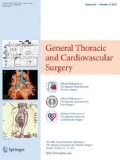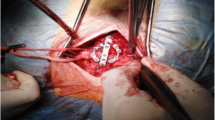Abstract
Objective
Sternum external fixation with a sternal wire is widely used. However, it was inadequate fixation in the anterior–posterior and cranial–caudal directions. Using sternal pins can improve the stability. The utility of a small deviation was important with respect to sternal pain. Here, we evaluated the efficacy of a sternal pin in a small deviation in three directions.
Methods
Polyurethane foam was used. In the wire group, models were closed using two stainless steel wires. In the wire and sternal pin group, a hydroxyapatite/poly-l-lactide acid (HA/PLLA) sternal pin was used for internal fixation in addition to wire fixation. A sternal pin was inserted inside. Both sides were fixed with the testing machine and the shear stress was directed to one side. In each group, six models were tested for three directions. The relationship between the load and displacement of the model was measured at 1-mm displacement.
Results
In the anterior–posterior direction, the load value was 138.8 ± 8.3 (N) in the wire and sternal pin group and 51.6 ± 9.5 (N) in the wire group (p = 0.0003). In the cranial–caudal direction, the values were 148.0 ± 12.0 (N) and 83.1 ± 26.6 (N), respectively (p < 0.0001). In the lateral direction, these values were 273.2 ± 49.3 (N) and 266.9 ± 50.6 (N), respectively (p = 0.8323).
Conclusions
Additional internal fixation using an HA/PLLA sternal pin significantly improved the stability of sternotomy closure in the anterior–posterior and cranial–caudal directions within a small deviation.




Similar content being viewed by others
References
Julian OC, Lopez-Belio M, Dye WS, Javid H, Grove WJ. The median sternal incision in intracardiac surgery with extracorporeal circulation; a general evaluation of its use in heart surgery. Surgery. 1957;42:753–61.
Goodman G, Palatianos GM, Bolooki H. Technique of closure of median sternotomy with trans-sternal figure-of-eight wires. J. Cardiovasc Surg (Torino). 1986;27:512–3.
Losanoff JE, Jones JW, Richmann BW. Primary closure of median sternotomy: techniques and principles. Cardiovasc Surg. 2002;10:102–10.
Negri A, Manfredi J, Terrini A, Rodella G, Bisleri G, El Quarra S, et al. Prospective evaluation of a new sternal closure method with thermoreactive clips. Eur J Cardiothorac Surg. 2002;22:571–5.
Tavilla G, Van Son JAM, Verhagen AF, Lacquet LK. Modified Robicsek technique for complicated sternal closure. Ann Thorac Surg. 1991;52:1179–80.
Cohen DJ, Griffin LV. A biomechanical comparison of three sternotomy closure techniques. Ann Thorac Surg. 2002;73:563–8.
Casha AR, Gauci M. Mechanical comparison of three sternotomy closure techniques using a polyurethane foam sternal model. Ann Thorac Surg. 2003;75:2009–10 (author reply 2010).
Saito T, Iguchi A, Sakurai M, Tabayashi K. Biomechanical study of a poly-l-lactide (PLLA) sternal pin in sternal closure after cardiothoracic surgery. Ann Thorac Surg. 2004;77(2):684–7.
Ozaki W, Buchman SR, Iannettoni MD, Frankenburg EP. Biomechanical study of sternal closure using rigid fixation techniques in human cadavers. Ann Thorac Surg. 1998;65:1660–5.
Casha AR, Yang L, Kay PH, Saleh M, Cooper GJ. A biomechanical study of median sternotomy closure techniques. Eur J Cardiothorac Surg. 1999;15:365–9.
Dasika UK, Trumble DR, Magovern JA. Lower sternal reinforcement improves the stability of sternal closure. Ann Thorac Surg. 2003;75:1618–21.
Sargent LA, Seyfer AE, Hollinger J, Hinson RM, Graeber GM. The healing sternum: a comparison of osseous healing with wire versus rigid fixation. Ann Thorac Surg. 1991;52:490–4.
Hendrickson SC, Koger KE, Morea CJ, Aponte RL, Smith PK, Levin LS. Sternal plating for the treatment of sternal non-union. Ann Thorac Surg. 1996;62:512–8.
Gottlieb LJ, Pielet RW, Karp RB, Krieger LM, Smith DJ Jr, Deeb GM. Rigid internal fixation of the sternum in postoperative mediastinitis. Arch Surg. 1994;129:489–93.
Song DH, Lohman RF, Renucci JD, Jeevanandam V, Raman J. Primary sternal plating in high-risk patients prevents mediastinitis. Eur J Cardiothorac Surg. 2004;26:367–72.
Nishimura T, Kurihara C, Sakano Y, Kyo S. Sternalock plating system for elderly post-sternotomy patients. J Artif Organs. 2014;17:288–90.
Adams J, Cline MJ, Hubbard M, McCullough T, Hartman J. A new paradigm for post-cardiac event resistance exercise guidelines. Am J Cardiol. 2006;97:281–6.
Trumble DR, McGregor WE, Magovern JA. Validation of a bone analog model for studies of sternal closure. Ann Thorac Surg. 2002;74:739–44 (discussion 745).
Szivek JA, Thomas M, Benjamin JB. Characterization of a synthetic foam as a model for human cancellous bone. J Appl Biomater. 1993;4:269–72.
Acknowledgment
The authors gratefully acknowledge the technical support of Hiroyuki Tsukui.
Conflict of interest
All the authors have no conflict of interest.
Author information
Authors and Affiliations
Corresponding author
Rights and permissions
About this article
Cite this article
Koshiyama, H., Yamazaki, K. Absorbable sternal pins improve sternal closure stability within a small deviation. Gen Thorac Cardiovasc Surg 63, 331–334 (2015). https://doi.org/10.1007/s11748-015-0533-z
Received:
Accepted:
Published:
Issue Date:
DOI: https://doi.org/10.1007/s11748-015-0533-z




